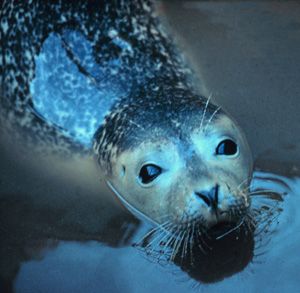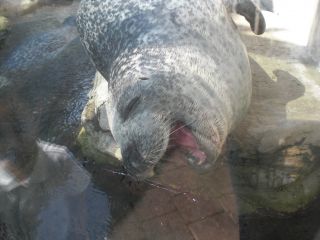Scent
Whiskers Seal the Deal
Sensitive whiskers help seals perceive underwater world
Posted July 13, 2012

Photo via NOAA
It's easy to overlook a seal's whiskers when faced with those puppy-dog eyes and smiling snout. But it's those vibration—sensitive whiskers that are the secret weapon in the seal's tracking arsenal, enabling them to find and chase prey they can't see or hear.
Harbor seals (Phoca vitulina), like many mammals, have sensitive whiskers that act as specialized touch organs. In a land—lubbing animal like the rat, whiskers work by brushing up against objects in the rat's path. The movements of the whiskers are detected by motion—sensing cells inside a heavily innervated hair follicle, and these nerves relay information about the direction, velocity, and duration of whisker movement to the brain, allowing the animal to detect the location, size, and other details of the object. Rats have about 100-200 nerve cells at the base of each whisker. Harbor seals have closer to 1,500.
Seals use their whiskers (the technical term for which is vibrissae) in a similar way as rats, only they do it underwater. Seal whiskers detect disturbances in the water, providing them with information about their surroundings. For seals searching for fish in dark or murky waters, whiskers can pick up invisible hydrodynamic trails left behind by prey. Seals use their whiskers to detect and interpret these trails.
Scientists like Wolf Hanke from the Marine Science Center at the University of Rostock, Germany, are testing how seals perceive the world through their extremely sensitive whiskers. He and colleagues Guido Dehnhardt, Björn Mauck, and Horst Bleckmann demonstrated that blindfolded harbor seals can use their whiskers to detect and track the hydrodynamic trails of miniature submarines for more than 130 feet. Hanke then co-authored a study in which a harbor seal was successfully trained to search for and track the trail left in the water by another seal after the trail-generating seal had left the water.

These experiments demonstrated the exquisite sensitivity of seal whiskers, but do not reveal much about how seals use their whiskers in natural conditions. In the wild, seals likely use their whiskers while hunting for a fish dinner. Underwater, murky or dark conditions can limit vision, and hearing is often useless, as swimming fish are usually silent. Water movements in the wake of fishes, however, can persist for several minutes, and generate hydrodynamic trails of a considerable length. These water trails are likely important to the success of hunting harbor seals.
The next question was how a seal would fare with a more fish—like hydrodynamic trail. Graduate student Sven Wieskotten teamed up with Hanke, Dehnhardt, Mauck, and Lars Miersch to find out how long a seal could track a trail generated by a moving fin. The study was published in 2010 in the Journal of Experimental Biology.
Perhaps the most important member of this experimental team was Henry, a now 12 year-old harbor seal living at the Marine Science Center in Germany who has a distinguished research career of his own. Henry is trained to perform certain tasks in exchange for a herring treat and has a long history of participating in such experiments. In this experiment, a blindfolded and headphone—wearing Henry was trained to respond to the hydrodynamic trail left by an artificial fish for as long as he could detect it. The artificial fish was essentially a rubber fin on a stick that created motions similar to the swimming motion of a real fish. The blindfold and headphones ensured Henry was not using visual or auditory cues, and thus depending only on what his whiskers told him. Wieskotten and Hanke trained Henry for this task in a boxed—in area of calm water. Henry was trained to poke his head under the water as the rubber fin was swept through the water and moved either to the left or to the right. The seal indicated which direction the fin moved by pointing his head in the proper direction.
After two months of training, the team allowed Henry to swim into the enclosure five seconds after the fin swept through the water. Guided only by his whiskers, Henry was able to correctly identify which direction the fin had moved with more than 90% accuracy. Wieskotten and Hanke gradually increased the length of the delay and were surprised when even after a 35 second delay, Henry indicted the correct direction of the fin with 70% accuracy. However, after 40 seconds he could no longer follow the trail.
In 35 seconds, a fish could cover more than 200 feet of ocean. Detection of prey from that distance rivals the echolocation abilities of dolphins and whales. So how is Henry doing it? The researchers determined that a swimming fish creates a series of vortices in the water that last for some time after the fish has moved on. Henry's whiskers detect these vortices, and may even be able to analyze the structure of the trail's vortices and jets to find out more about its source.

The size and shape of a fish can affect the structure of this wake, which raised the question: Could a seal distinguish between different objects, even different species of fish, based on their hydrodynamic trails? Wieskotten and Hanke brought the team back together to answer this question in a new experiment, published in 2011 in the Journal of Experimental Biology.
Henry donned his blindfold and earphones, and after more than six months of training, he was ready to show his skills. Wieskotten and Hanke were interested in Henry's ability to distinguish between the hydrodynamic trails of differently sized paddles. Inside a large box in the seal's enclosure, an electric motor swept a paddle around the water. Henry was allowed to enter the box three seconds after the paddle finished its sweep. In the first part of the experiment, the paddles differed only in size, not in shape. The team found Henry could distinguish the wakes of paddles that differed by as little as 2.8 cm in width.
Wieskotten and Hanke then tested Henry with a variety of paddle shapes, asking him to distinguish between the trails of triangular, cylindrical, flat, and undulating paddles. He was successful at distinguishing between the flat and cylindrical paddles, the flat and the undulating paddles, and the undulating and cylindrical paddles after they were swept through the box. He did have trouble, however, telling apart the triangular paddle from the undulating or cylindrical ones.
Hanke, Wieskotten and their colleagues think the remarkable whiskers reveal a great deal about how seals hunt fish in murky ocean depths. Sensitive whiskers could allow seals to discriminate fish of different size and shape and allow them to optimize their hunting behavior to suit particular prey. Seals may also be able to tell whether a particular fish, from its wake, is worth the time and effort, and focus their foraging efforts on those fish with the highest caloric reward.
These experiments show that the sensitive whiskers of seals are able to detect minute disturbances in the water, like the tiny trails of vortices left by a fish up to half a minute after it has passed. And seals have the ability to analyze a hydrodynamic trail to gain some knowledge of the size and shape of its maker. In the ocean, where vision and hearing won't always be helpful, seals are able to follow these wakes, like a dog following a scent trail on land.




